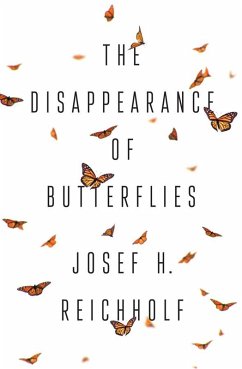In the last fifty years our butterfly populations have declined by more than eighty per cent and butterflies are now facing the very real prospect of extinction. It is hard to remember the time when fields and meadows were full of these beautiful, delicate creatures - today we rarely catch a glimpse of the Wild Cherry Sphinx moths, Duke of Burgundy or the even once common Small Tortoiseshell butterflies. The High Brown Fritillary butterfly and the Stout Dart Moth have virtually disappeared. The eminent entomologist and award-winning author Josef H. Reichholf began studying butterflies in the late 1950s. He brings a lifetime of scientific experience and expertise to bear on one of the great environmental catastrophes of our time. He takes us on a journey into the wonderful world of butterflies - from the small nymphs that emerge from lakes in air bubbles to the trusting purple emperors drunk on toad poison - and immerses us in a world that we are in danger of losing forever. Step by step he explains the science behind this impending ecological disaster, and shows how it is linked to pesticides, over-fertilization and the intensive farming practices of the agribusiness. His book is a passionate plea for biodiversity and the protection of butterflies.
Dieser Download kann aus rechtlichen Gründen nur mit Rechnungsadresse in D ausgeliefert werden.
"The Disappearance of Butterflies is in many ways the fulfilment of Reichholf's entire 50-year career."
New Statesman
"This is a brilliant, authoritative and iconoclastic challenge to the industrial farming that is destroying insect life. But Josef Reichholf's lifetime of scrupulous scientific observation of butterflies and moths does not lead to despondency. He identifies overlooked solutions, from discarding fertiliser to embracing disorder and greening cities. And he reveals more of the miraculous biology of butterflies and moths, and their marvellous relationships with a whole web of life - including us."
Patrick Barkham, author of The Butterly Isles
"This engaging book, based on personal observations of the author and a broad reading of the literature, celebrates the wonderful diversity of butterflies and moths, and laments their ongoing decline in response to loss of natural habitat and intense agricultural practices. Reichholf introduces the reader tothe general biology of Lepidoptera, as well as highlighting the special adaptations of some groups to their particular, and sometimes peculiar, ways of life. The second part of the book addresses the decline of butterflies and moths, why this should matter to us, and what we can do about it. Among its surprises are the roles of urban areas as refuges for some species. Reichholf makes the case that diversity is important and worth conserving, both for the functioning of the natural environment and for the pleasure we humans derive from nature."
Robert E. Ricklefs, University of Missouri-St. Louis
"The beauty, individuality and unique characteristics of butterflies and moths are brought to life in the first half of this authoritative book. The pages filled with a lifetime of personal experiences, scientific research and case studies. But it is the second half that really captured my imagination. Addressing the devastating decline of lepidoptera, Reichholf outlines why this should matter to us and what we can do about it. With striking insight into why over fertilisation, industrial agriculture and habitat degradation are crippling for biodiversity, the author offers hope through a range of solutions."
Lindsey Chapman, Discover Wildlife
"Fascinating"
Visions for Sustainability
"Eloquent, detailed, expertly organized and presented, The Disappearance of Butterflies is a definitive study that will have immense value to students, scientists, and the general public alike."
Midwest Book Review
New Statesman
"This is a brilliant, authoritative and iconoclastic challenge to the industrial farming that is destroying insect life. But Josef Reichholf's lifetime of scrupulous scientific observation of butterflies and moths does not lead to despondency. He identifies overlooked solutions, from discarding fertiliser to embracing disorder and greening cities. And he reveals more of the miraculous biology of butterflies and moths, and their marvellous relationships with a whole web of life - including us."
Patrick Barkham, author of The Butterly Isles
"This engaging book, based on personal observations of the author and a broad reading of the literature, celebrates the wonderful diversity of butterflies and moths, and laments their ongoing decline in response to loss of natural habitat and intense agricultural practices. Reichholf introduces the reader tothe general biology of Lepidoptera, as well as highlighting the special adaptations of some groups to their particular, and sometimes peculiar, ways of life. The second part of the book addresses the decline of butterflies and moths, why this should matter to us, and what we can do about it. Among its surprises are the roles of urban areas as refuges for some species. Reichholf makes the case that diversity is important and worth conserving, both for the functioning of the natural environment and for the pleasure we humans derive from nature."
Robert E. Ricklefs, University of Missouri-St. Louis
"The beauty, individuality and unique characteristics of butterflies and moths are brought to life in the first half of this authoritative book. The pages filled with a lifetime of personal experiences, scientific research and case studies. But it is the second half that really captured my imagination. Addressing the devastating decline of lepidoptera, Reichholf outlines why this should matter to us and what we can do about it. With striking insight into why over fertilisation, industrial agriculture and habitat degradation are crippling for biodiversity, the author offers hope through a range of solutions."
Lindsey Chapman, Discover Wildlife
"Fascinating"
Visions for Sustainability
"Eloquent, detailed, expertly organized and presented, The Disappearance of Butterflies is a definitive study that will have immense value to students, scientists, and the general public alike."
Midwest Book Review









